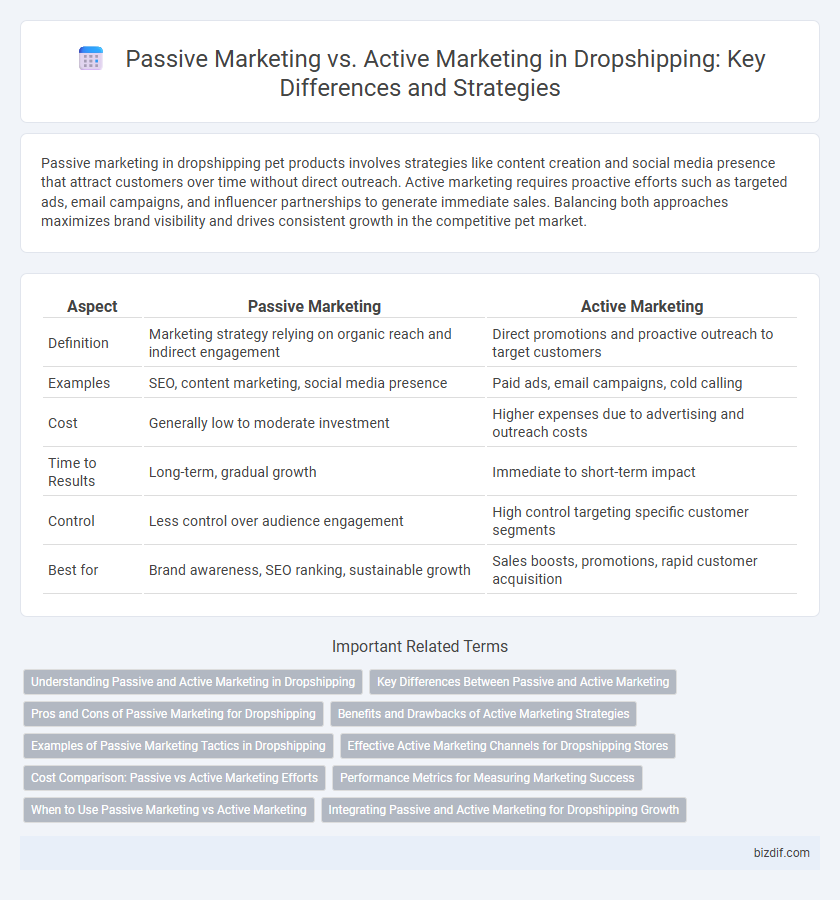Passive marketing in dropshipping pet products involves strategies like content creation and social media presence that attract customers over time without direct outreach. Active marketing requires proactive efforts such as targeted ads, email campaigns, and influencer partnerships to generate immediate sales. Balancing both approaches maximizes brand visibility and drives consistent growth in the competitive pet market.
Table of Comparison
| Aspect | Passive Marketing | Active Marketing |
|---|---|---|
| Definition | Marketing strategy relying on organic reach and indirect engagement | Direct promotions and proactive outreach to target customers |
| Examples | SEO, content marketing, social media presence | Paid ads, email campaigns, cold calling |
| Cost | Generally low to moderate investment | Higher expenses due to advertising and outreach costs |
| Time to Results | Long-term, gradual growth | Immediate to short-term impact |
| Control | Less control over audience engagement | High control targeting specific customer segments |
| Best for | Brand awareness, SEO ranking, sustainable growth | Sales boosts, promotions, rapid customer acquisition |
Understanding Passive and Active Marketing in Dropshipping
Passive marketing in dropshipping involves strategies such as SEO optimization, content creation, and social media presence that attract potential customers over time without direct interaction. Active marketing relies on paid advertisements, email campaigns, and influencer partnerships to immediately engage and convert target audiences. Understanding the balance between passive methods that build brand awareness and active tactics that drive quick sales is essential for sustainable growth in dropshipping businesses.
Key Differences Between Passive and Active Marketing
Passive marketing relies on tactics such as content creation, SEO, and social media presence to attract customers over time, emphasizing long-term brand visibility. Active marketing involves direct actions like paid ads, email campaigns, and promotions aimed at immediate engagement and conversions. The key differences lie in their approach to customer interaction, timing of results, and resource allocation, with passive marketing focusing on organic growth and active marketing targeting quick, measurable outcomes.
Pros and Cons of Passive Marketing for Dropshipping
Passive marketing in dropshipping involves strategies such as SEO, content marketing, and social media presence that generate organic traffic without constant effort. Its main advantage is cost-effectiveness and the ability to build trust and long-term brand authority, but it requires significant time investment and patience to see measurable results. A downside is limited control over immediate sales performance, making it less effective for quick product launches or promotions compared to active marketing tactics.
Benefits and Drawbacks of Active Marketing Strategies
Active marketing strategies in dropshipping, such as paid ads, influencer partnerships, and email campaigns, drive immediate traffic and sales by targeting specific audience segments with tailored messages. These methods offer precise control over campaign performance and faster ROI but require ongoing investment, constant optimization, and can lead to high customer acquisition costs. While active marketing boosts brand visibility and engagement quickly, it demands significant time, budget, and expertise compared to more passive approaches like SEO or content marketing.
Examples of Passive Marketing Tactics in Dropshipping
Passive marketing tactics in dropshipping include content marketing through SEO-optimized blog posts, leveraging social media profiles with evergreen posts, and building email lists for automated drip campaigns. Utilizing customer reviews and testimonials on product pages enhances credibility and drives organic traffic without active promotion. Affiliate marketing partnerships also attract customers through third-party endorsements, minimizing direct outreach efforts.
Effective Active Marketing Channels for Dropshipping Stores
Effective active marketing channels for dropshipping stores include paid social media advertising on platforms like Facebook and Instagram, which deliver highly targeted traffic and immediate sales potential. Search engine marketing (SEM) through Google Ads increases visibility by capturing high-intent customers actively searching for products. Email marketing campaigns foster customer retention and repeat purchases by sending personalized offers and updates directly to subscribers' inboxes.
Cost Comparison: Passive vs Active Marketing Efforts
Passive marketing in dropshipping typically incurs lower upfront costs as it relies on organic methods like SEO and content marketing, reducing the need for continuous spending. Active marketing requires ongoing budget allocation for ads, promotions, and influencer partnerships, often leading to higher expenses but faster traffic and conversions. Evaluating cost-effectiveness involves analyzing ROI over time, where passive strategies build value gradually while active campaigns demand immediate investment.
Performance Metrics for Measuring Marketing Success
Passive marketing in dropshipping relies on organic traffic and brand presence, measured by metrics such as website visits, social media engagement, and audience growth. Active marketing employs targeted campaigns like paid ads and email promotions, with success tracked through conversion rates, return on ad spend (ROAS), and customer acquisition cost (CAC). Analyzing these performance metrics helps optimize marketing strategies by balancing customer reach and cost efficiency.
When to Use Passive Marketing vs Active Marketing
Passive marketing is ideal for long-term brand building and attracting customers through consistent content creation, SEO, and social media presence in dropshipping. Active marketing excels during product launches, promotions, or targeting immediate sales with paid ads, email campaigns, and influencer collaborations. Choosing between passive and active marketing depends on whether the goal is sustained growth or quick revenue spikes in your dropshipping business.
Integrating Passive and Active Marketing for Dropshipping Growth
Integrating passive and active marketing strategies is essential for sustainable dropshipping growth, combining the long-term benefits of SEO, content marketing, and social media presence with the immediate impact of paid ads and email campaigns. Leveraging data analytics to refine paid advertising while cultivating organic traffic through quality content maximizes conversion rates and customer retention. Efficiently balancing automation tools for passive outreach with personalized active engagement ensures continuous brand visibility and scalable revenue streams in competitive dropshipping markets.
Passive Marketing vs Active Marketing Infographic

 bizdif.com
bizdif.com